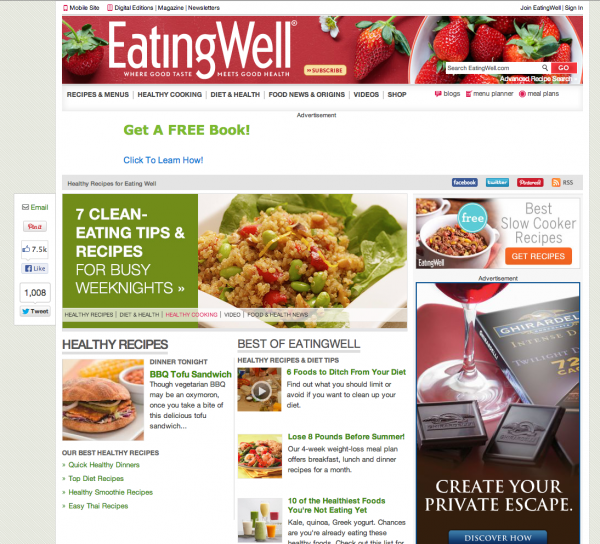Subscription website publishing demands an audience and EatingWell demonstrates how to get one to its new owner

We talk a lot about the Online Magazine Index – OMI – that’s a fairly accurate measure of a publisher’s Internet savvy. In subscription website publishing, you should easily have more unique visitors to your website than you have print subscribers.
If you’re not driving more Internet traffic than you are selling paid subscriptions, something’s desperately wrong with your audience development program. And if you don’t have an audience on the Internet, you’re going to be invisible in the coming years as print fades away and subscription website publishing becomes the only game in town.
Of course, audience development is what Mequoda’s all about, so if you do the OMI math – divide your uniques by your paid circ – and get less than 1, you need to start downloading some free handbooks, or attending our Digital Publishing and Marketing Intensives pronto!
In the meantime, I want to follow up on a point I noted last week in my rant about magazine pricing. In comparing what we call “nimble niche players” with good OMIs, I discovered that all of them but one also had solid pricing strategies. That one exception was EatingWell, a Meredith publication. For all of its amazing content – recipes, diets, menus, health advice and more – its subscribers are paying a mere $9.99 a year. And if you go to Amazon, you can get it for $5!
[text_ad]
EatingWell: Dragging a subscription website publishing dinosaur into the modern age
The very idea of a $5 subscription makes me feel faint. And in fact, all Meredith publications are essentially giving away their content, presumably in the interest of maintaining their advertising rate base. At Mequoda, we think that’s terribly shortsighted. Advertisers are abandoning print for digital magazines in droves, but leading American publications like Ladies Home Journal, with an OMI of 0.02, Family Circle at 0.03, and Better Homes & Gardens, at 0.12, will be lucky going forward to get a fraction of that business.
This makes EatingWell a golden child at Meredith. No doubt this is because it’s a recent acquisition, and not a product of Meredith’s overall laggard response to the digital age. According to Meredith, when they bought the magazine in 2011 it had significant digital assets that no doubt appealed to a company still in the Jurassic Era of subscription website publishing.
These included their content-rich subscription website, whose 2.4 million uniques per month put it in the top 25 food sites; a robust content licensing program which puts Eating Well content in view of millions of other consumers at places like MSN Healthy Living and WebMD; and even a mobile recipe app rated as a top foodie app by the iTunes store and top health app by Consumer Reports Health Newsletter.
Of course we must give credit to Meredith where it’s due, because the mega-publisher has expansive resources and reach within the huge women’s market, and EatingWell’s paid circulation has increased under Meredith by almost 50% since June 2011. If the example set by EatingWell for expert subscription website publishing makes Meredith a better company, then this will turn out to be one of the more advantageous acquisitions in recent publishing history.
[text_ad]
Subscription website publishing 101
EatingWell shows us how subscription website publishing should be done. For starters, the magazine lives on Mequoda’s “nimble niche players” list with a healthy OMI of 3.97. Compare that to its Meredith siblings that I mentioned above! In fact, Meredith still hasn’t gotten around to even offering a digital edition of two of its biggest magazines, Ladies Home Journal and Family Circle. EatingWell was indeed a digital shot in the arm for Meredith.
It’s easy to see how EatingWell pumps up its monthly visitor count. It deploys most of the elements of the Mequoda Method on its website. There’s lots of free content to make readers eager to visit often, daily blogs promoting the magazine, and free newsletters to keep their followers engaged.
At Mequoda, of course, we constantly preach about the importance of SEO in driving traffic, and EatingWell would appear to have this critical subscription website publishing strategy nailed down. I searched for several variations on “blood pressure recipes,” and their blood pressure category page popped up in the #1 position on the Google results page every time.
They turn up fifth for “heart-healthy diet” (the Mayo Clinic, U.S. News & World Reports Health and heart.org coming in ahead of them), and third and fourth for “weight-loss diet” (WebMD.com and U.S. News beating them). These kinds of rankings are what’s behind their growing Internet traffic, averaging 2.4 million unique visitors a month since June 2011, when Meredith acquired the magazine and average monthly visitors were only 900,000.
It’s especially impressive considering the brutal competition in this niche. Of course, we’d like to think that this is partly because EatingWell follows a Mequoda Best Practice of offering free content in exchange for an email address. EatingWell offers free cookbooks, promoted on more than 500 pages where relevant content resides, and also promoted on recipes and in the right rail.
All in all, there’s a lot to like about EatingWell’s subscription website publishing efforts. If you’re in a cutthroat niche like cooking or healthy eating, these folks are worthy mentors. And remember, they set their marketing programs in motion without the help of a major publishing company, so we think that’s proof that any independent publisher can do the same!
If you’re struggling with audience development, or you fear you’re a digital dinosaur, feel free to ask for help. At Mequoda we want everyone to make more money on the Internet, from mega-publishers like Meredith down to the tiniest non-profit. Got question? Ask ‘em here, or contact us for more in-depth advice!


